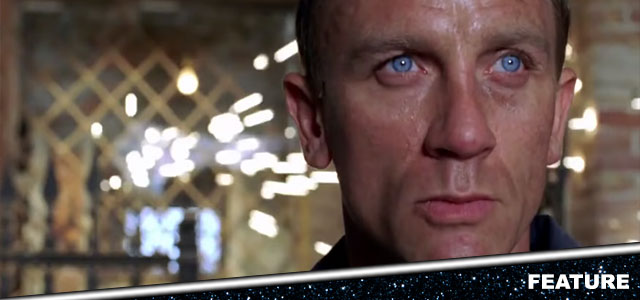
The 25th James Bond movie No Time To Die arrives in Cineworld in September, and we're counting down the days by revisiting all the 007 movies in chronological order of release.
In honour of Daniel Craig's swansong as 007, we're taking a nostalgic trip back through time. This week: Craig makes his Bond debut in Casino Royale.
What is the story of Casino Royale?
British agent James Bond (Daniel Craig) is earning his stripes as a '00' operative within MI6. When he intercepts and kills a bombmaker in Madagascar, Bond is admonished by his boss, M (Judi Dench), for violating multiple international treaties. Nevertheless, the maverick agent continues the trail to the Bahamas and later to Miami airport, where he prevents the destruction of a valuable aircraft.
Bond's intervention puts terrorist middleman, and key MI6 target, Le Chiffre (Mads Mikkelsen) in a tricky position. He's been gambling on the stock market with funds from a violent African warlord, and the incident in Miami threatens to put him out of pocket. He enters a high-stakes poker game at the Casino Royale in Montenegro to make the money back, and Bond is dispatched to beat him, which will force Le Chiffre into seeking asylum with the British government.
However, along the way, Bond finds his heart captured by the alluring and beautiful treasury operative Vesper Lynd (Eva Green), who may indicate a possible way out of the lifestyle to which he's committed himself...
How did Casino Royale get made?
In the mid-noughties, the world of James Bond seemed dangerously out of date. The final Bond movie to feature Pierce Brosnan, Die Another Day, had been released in 2002, and, despite huge box office grosses (it was the most commercially successful Bond film up to that point), critics and audiences castigated it. The age-old formula of quips, casual sexism, nonsensical plotting and poor effects was no longer good enough for more discerning audiences, causing Brosnan to be dropped in 2004, while producers Michael G. Wilson and Barbara Broccoli looked to take everything back to basics.
Wider global trends were reflected in critical and commercial success stories such as the first two Bourne movies, released in 2002 and 2004. Matt Damon's amnesiac assassin Jason Bourne was not just thrilling to watch but also palpably human, an assassin in search of himself. This carried far more weight than a moronic spy adventure involving diamonds and space lasers. Likewise, Christopher Nolan's Batman Begins, released in 2005, showed the lucrative potential of wiping the slate clean and taking an iconic character back to where he first started.
Little wonder, then, that this was the approach that informed Casino Royale, eventually released in 2006. With Brosnan axed from the role, speculation was rife at the time as to who would take over. When British actor Daniel Craig was announced in October 2005 (beating the likes of Henry Cavill), the press whipped up a maelstrom that certain members of the public were eager to latch onto. Admittedly, the actor was known for low-key, intense portrayals in the likes of Love Is The Devil, Enduring Love, and Steven Spielberg's Munich, rather than action movies, but the ferocity with which Craig was attacked was startling.
Everything from Craig's blonde hair to his decision to wear a life preserver while travelling by boat to his debut press event was picked apart and scrutinised. Entire websites sneering at the so-called 'blonde Bond' popped up, including danielcraigisnotmybond.com. The actor himself admitted to have been rocked by the negativity, but the egg was eventually on the face of the naysayers, as he magnificently reinvented the role, and made Bond human for the first time since Timothy Dalton's shortlived 1980s tenure.
Craig discovered he had the role while browsing in an American supermarket, off-duty while filming sci-fi thriller The Invasion. The actor admitted to immediately ditching his groceries and later getting leathered on vodka. Such is the magnitude of the role, and the impact it has on those playing Bond; few characters in pop culture come freighted with so much expectation or responsibility. Craig's approach was to return to the gritty, down to Earth atmosphere of original author Ian Fleming, whose 1953 novel Casino Royale (his first Bond book) informed the title and storyline of the movie. What we got was a Bond in the earliest stages of his development, a reckless agent who must learn from his mistakes and eventually grow into his own legend.
It was a spectacularly successful decision that allowed audiences to properly invest in the character. And besides Craig's casting, there were several other reasons why the movie worked, starting with director Martin Campbell. Back in 1995, Campbell demonstrated sensitivity and intuition when making Pierce Brosnan movie GoldenEye, the movie that saved the Bond franchise from years of legal wranglings. Campbell located GoldenEye in a post-Cold War world, and Bond's fight to stay relevant is key to the film's storyline, not just a figurative expression of the time in which it was made.
Campbell performed the same trick with Casino Royale, tackling a Bond in the troubled, post-9/11 era, one who is a hero, but difficult, stubborn and often misguided with it. As M would say in later Bond movie Skyfall, the world is no longer transparent but more opaque than ever, and audiences were eager to lap up a hero with flashes of darkness and grit within. Such fallibility makes them more empathetic as far as an audience is concerned, and this plays to Campbell's strengths as a filmmaker. Interestingly, he was employed after Quentin Tarantino had expressed interest in adapting Casino Royale with Pierce Brosnan starring; needless to say, production company Eon wasn't interested.
Producers Broccoli and Wilson also made the sage decision to add Paul Haggis to the in-house writing team of Neal Purvis and Robert Wade. Haggis had won several Oscars in 2005 for his acclaimed race-relations drama Crash, demonstrating his facility with character development and complex, multi-stranded storytelling. It's not hard to discern his mature touch during the emotive scenes between Bond and Vesper; rarely, if ever in the franchise, had exchanges between Bond and his leading lady crackled with so much chemistry and conviction. (At least, not since 1969 George Lazenby vehicle On Her Majesty's Secret Service, where 007 gets married to Diana Rigg's ill-fated Tracy.)
That said, Haggis told The Guardian in 2007 that his main responsibility was to rewrite the climax of the film, infusing it with greater depth and properly concluding the act of Vesper Lynd's betrayal. "The draft that was there was very faithful to the book and there was a confession, so in the original draft, the character confessed and killed herself. She then sent Bond to chase after the villains; Bond chased the villains into the house. I don't know why but I thought that Vesper had to be in the sinking house and Bond has to want to kill her and then try and save her."
The movie's level of sharp wit, both visual and verbal, only enhances the sense of enjoyment. When Vesper suggests she's not Bond's type because she's smart, he retorts it's because she's single. Although this movie, chronologically speaking, takes place at the beginning of Bond's time as a 00 agent, it's a clear and spirited rebuke to all those off-screen marriages the other Bonds must have ruined during their time. And in a franchise that's been accused (not unjustly) of exploiting its female characters, it's refreshing to have Bond's body put on display for a change, in the immediately notorious and much-parodied swimming trunks scene. Not only does it show off Craig's physique, it demonstrates the movie is in the hand of smart filmmakers who are quick to puncture and send up the classic Bond mythology.
Additional tweaks come in the scene where Bond orders his first vodka martini; prompted as to how he wants it, he tersely replies, "Does it look like I give a damn?" Perhaps the most radical reinvention of the formula comes at the very beginning, with a stylish black and white assassination sequence that is revealed to be the foundation of the opening gunbarrel.
The filmmakers also wisely retained the services of Judi Dench as M, whose presence Craig clearly relishes, as Bond and his superior go head to head. The already chippy chemistry Dench had shared with Pierce Brosnan now gains added layers of complexity, as she's forced to guide her most talented MI6 recruit through his formative development. In the Craig movies, Dench emerges as a somewhat maternal figure, although severe and professional with it, and this undercurrent would receive its fullest, most moving expression in 2012 Bond movie Skyfall.
The close attention to detail in the direction, screenwriting and casting was so far beyond anything achieved in the Brosnan era, audiences were left wondering why the franchise hadn't managed it sooner. The film's strengths extend to its rich supporting cast, chiefly Eva Green as the tormented Vesper, arguably the most conflicted and compelling female Bond character of them all. (Green got the role after beating the likes of Angelina Jolie and Charlize Theron, while Cecile de France was close to being cast, but couldn't master the English accent.)
Vesper is derived from Fleming's original novel (so named because she was "born on a very stormy evening"); there, as per the film, she offers Bond a glimpse of the life he could enjoy beyond the secret service, which means that the act of her eventual betrayal scars him very deeply. (Also as per the book, he names the vodka martini cocktail directly after her.) The trace elements of Vesper's decision were subtly referenced in many later Fleming books, and 2008 sequel Quantum of Solace examined the emotional fallout from the events of Casino Royale.
It was another sign of how much the filmmakers sought to invest plausibility into the Bond template. This also feeds into the effective casting of Danish actor Mads Mikkelsen as an altogether more realistic villain, Le Chiffre. Mikkelsen, best known for the dark movies of director Nicolas Winding Refn, confessed to not being a Bond fan, and it's this very aversion to the cat-stroking, maniacal cliches that makes Le Chiffre ('the number') all the eerier. Even his signature defect, an eye that weeps blood, is deployed to far more subtle effect than one expects.
The one moment of explosively savage violence enjoyed by Le Chiffre sums up the philosophy of this new, more grounded Bond movie. This is, of course, the notorious sequence where Bond is stripped naked, tied to a chair and whipped with a piece of knotted rope, another element that owes a debt to Ian Fleming's original source. It was highly unusual to see an act of violence like this perpetuated against Bond (at least, outside of Die Another Day and the Dalton movies), and showcased Craig's physical commitment to the part. The brilliance of the scene is that Bond has the psychological upper-hand over Le Chiffre, capable of withstanding high levels of pain and forcing his torturer to the edge of reason; once again, it's not just flash and spectacle, but a scene infused with real emotional credibility.
When the filmmakers submitted the movie to the British Board of Film Classification (the BBFC), they were advised that the intensity of the sequence would land the movie with a 15 certificate. Outside of 1989's Licence To Kill, this was unheard of in the franchise, although certain Pierce Brosnan movies were initially released 15 uncut on DVD, before later being downgraded again to what was, at the time, a 12 certificate. The production was forced to tone down the vehemence of the torture scene, and upon resubmitting it to the BBFC, Casino Royale was passed 12A, albeit a very strong one. If anyone needed proof that the flimsy and lightweight Brosnan era had been left behind, this was it.
Casino Royale was filmed internationally on a budget of $150 million, just $8 million more than what Die Another Day had cost to make. Interiors made use of the 007 Stage at Pinewood Studios, which suffered one of its regular fires in mid-2006 after principal photography had finished; it was later rebuilt in less than six months. In terms of actual locations, the story takes place in Montenegro, a topical move in 2006 as the country had just achieved independent status. However, the shots involving the exterior of the Casino Royale were filmed in Karlovy Vary in the Czech Republic. Additional locations included the Bahamas, Venice and Mbale in Uganda.
Dunsfold Aerodrome in Surrey, best known as the home of the Jeremy Clarkson-fronted Top Gear, stood in for Miami Airport during the spectacular chase sequence that ensues between Bond and his quarry. The Millbrook Proving Ground was a substitute for Montenegro during the scene where Bond pursues a kidnapped Vesper and is forced to crash his Aston Martin in the process.
The action sequences in Casino Royale are key to its success: outlandish, for sure, but with an appreciably physical and practical element that helps engage an audience's attention. Under the close supervision of Campbell and second unit director Alexander Witt, not to mention the crisp editing of veteran Stuart Baird, the set-pieces have logical geography and coherency to them, which makes the action all the more exciting to experience.
The celebrated opening chase sequence through a Madagascan construction site and embassy, although it owes a clear debt to the Bourne movies, gets things off on a ferocious note. The sequence enlists the on-screen participation of parkour expert Sebastien Foucan, who plays the bomb maker that Bond is pursuing. And for all the apparent ridiculousness of what's happening on screen, it's all located in the physical capabilities of the performers. Note also the cut to the overhead shot during the airport chase where Bond flings himself from a petrol tanker to avoid being crushed by an onward-approaching vehicle; such small but impactful details make for a fantastic Bond movie.
There's also the shockingly violent and bloody stairwell fight between Bond and mercenary Obanno (Isaach De Bankole), in which Vesper is forced to reluctantly intervene. This later sets up the deeply affecting shower scene where he has to wash the 'blood' from her hands. No movie since the Dalton era had approached this level of brutality, yet Craig is what makes it work.
The actor's level of conviction radiates in both the fight sequences and the smaller moments. In the scene where Bond realises he has compromised Solange (Caterina Murino) for information, leading to her torture and death, director Campbell has the camera track slowly into Craig's scarred face, showing us a Bond who, for once, is comprehending the magnitude of his actions. It's a powerfully subtle and brilliant little detail. And it's not just exploited for pathos, either: the moment where Bond maliciously straps the bomb to his Miami airport target, smiling as he explodes (off-screen), is darkly funny and a reflection of a Bond who isn't necessarily above those whom he kills.
Put simply, this felt like the 007 we'd been waiting for all our lives, or at least since Sean Connery bowed out in the 1960s.
READ MORE
- No Time To Die and the 6 James Bond movies we never got to see
- 7 actors who could play James Bond after Daniel Craig retires
- Shaken and stirred! Daniel Craig's defining 007 moments
What music is on the Casino Royale soundtrack?
For the first time since becoming the in-house Bond composer in 1997, David Arnold finally had some meaty and memorable material to work with. He had contributed terrific scores for Brosnan movies Tomorrow Never Dies and The World Is Not Enough (less so for Die Another Day), but, like everyone else involved, was stymied by the reliance on noisy set-pieces above all else.
With Casino Royale, he was capable of scoring not just an action movie but also an intense character study. And fortunately, Arnold also got to take the reins on the opening title song, a responsibility that had been denied him on Die Another Day. (On Tomorrow Never Dies, his intended opening credits collaboration with k.d. lang was demoted to the end credits.) Arnold worked with the late Chris Cornell, formerly of band Audioslave, to conjure the terrific 'You Know My Name', a hard-rocking 007 number that's all about act of transformation, of becoming an icon. It was the first Bond song since 1983's Octopussy to not incorporate the film's title, and Cornell was the first male artist to have performed a Bond song since a-ha with 1987's The Living Daylights.
When heard in conjunction with Danny Kleinman's arresting main title designs, it works a treat. Kleinman, who had first started work on Bond with 1995's GoldenEye, was inspired by the front cover of the original 1953 edition of Fleming's Casino Royale. "The hearts not only represent cards but the tribulations of Bond's love story. So I took that as inspiration to use playing card graphics in different ways in the titles," he explained. Certainly, it makes a refreshing change from the scantily clad women often associated with the Bond credits sequences.
As always, when the Bond composer is involved in the song, it creates a thrilling synergy with the accompanying score. Because Casino Royale shows us a Bond in the process of becoming 007, it made sense for Arnold to withhold the actual Bond theme until the end credits. The majority of the score incorporates the 'You Know My Name' theme as a kind of proto-Bond piece, swaggering with energy and charisma, and capturing the rougher, more violent edge of Craig's portrayal.
The theme is regularly deployed either in standalone form (the rollicking 'Blunt Instrument') or in piecemeal fashion. The extended action sequences, for which Arnold has a flair, deploy the full force of the horns, trumpets and trombones to capture the hard-edged heroism of Craig's Bond, building a ferocious head of steam in tracks such as 'African Rundown' (accompanied with all manner of exotic percussion), and the mammoth, 12-minute 'Miami International'. The brassy reveal of the Skyfleet aircraft midway through the track is an especially magnificent homage to original Bond composer John Barry, in whose footsteps Arnold has always trodden.
Unlike Die Another Day, in this score, Arnold favours the organic tone of the orchestra above samples and electronics (although they are still present), working with regular orchestrator Nicholas Dodd to fashion some truly breathless, adrenaline-inducing set-pieces. The music is a mature extension of the thrilling work Arnold had deployed on the earlier Brosnan vehicles, possessed of regular key changes, intervals and shifts in tempo to mirror the frantic action on the screen.
As a film, Casino Royale hits a complex number of emotional registers, showing us the difficulty of Bond becoming 007. The horror stylings of 'Dirty Martini' with its shrill, stabbing strings are unlike most other Bond scores, although the majority of the poker scenes are understandably scored with pensive little cells of woodwinds and strings, reflecting the mind games that are ongoing.
The score's heart is found in the material for Bond and Vesper, as Arnold crafts a beautifully longing and tender theme for strings that owes a clear homage to Barry's romantic style. The likes of 'Vesper', 'City of Lovers' and the climactic, tragic 'The Bitch Is Dead' (a quote taken straight from Fleming's source) surge with humanism and empathy. Arnold is clearly inspired by the presence of Vesper as more than just a disposable love interest; she's the character who "strips" Bond's armour from him, and the sincere tone of the music follows suit.
And, of course, the ultimate unveiling of the James Bond theme in all its raucous glory is impactful precisely because it's been withheld. This is the moment that cements Craig not just as Bond, but 007 as well. And Arnold's terrific music is a vital character in helping us to believe it.
How was Casino Royale received?
Casino Royale had its premiere in Leicester Square on the 14th of November 2006 (a longstanding Bond tradition) and was released in the UK on the 16th of November. It received an ecstatic response from critics and audiences worldwide, which confirmed one thing absolute: Daniel Craig was indeed a bold and brilliant new Bond for a new generation.
The movie galvanized the franchise, showing that gadgets and flippant one-liners weren't needed to keep it alive. Casino Royale was another sign of the series' adaptability, a reflection of how Bond as a franchise is beholden to the political and pop culture landscape of the time. In this instance, it was clear that pyrotechnics weren't enough; 2006 audiences needed to actively care about what was happening, and Craig's portrayal was key to that impact.
Against its $150 million budget, Casino Royale grossed $606 million across the world, making it the most financially successful Bond movie to date. It was vindication for Craig's casting, something considered a huge risk at the time, and proof positive that he could carry the franchise forward.
Noted film critic Roger Ebert wrote: "Craig makes a superb Bond ... who gives the sense of a hard man, wounded by life and his job, who nevertheless cares about people and right and wrong." The movie went on to feature on multiple 'best of the year' critics lists, and also emerged as an awards-worthy movie, something only a handful of Bond films have managed.
At the 2007 BAFTAs, the movie walked away with the awards for Best Sound and the Rising Star (awarded to Eva Green). Craig himself was nominated, and the movie also achieved nods for Best British Film of the Year, Best Adapted Screenplay and Best Original Score for David Arnold.
After years of relatively frothy Pierce Brosnan movies, Bond was back, and once again a force to be reckoned with.
What was the next movie in the James Bond series?
Daniel Craig returned as 007 in Quantum of Solace, released in 2008.
When is No Time To Die released in the UK?
Click here to book your tickets for No Time To Die, which is released on 30th September. Don't forget to tweet us your favourite James Bond movies @Cineworld.




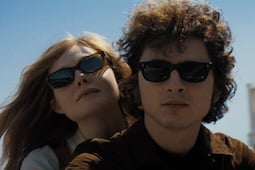

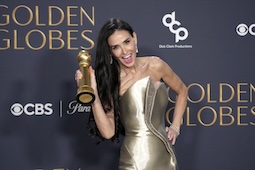
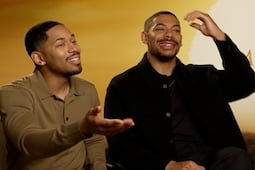

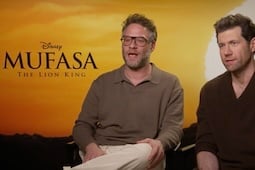




.jpg)
.png)






